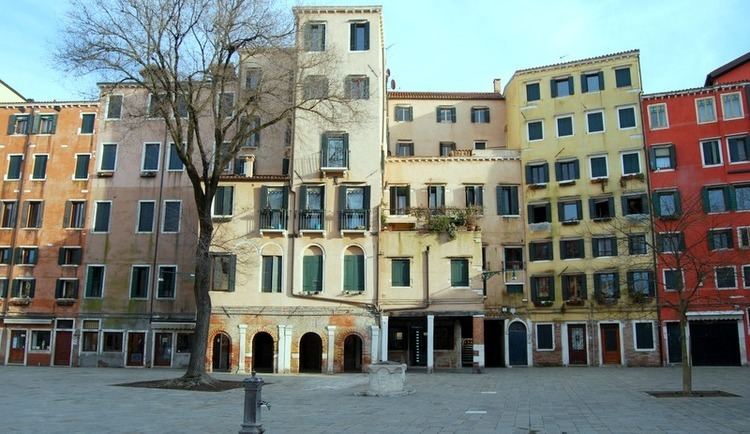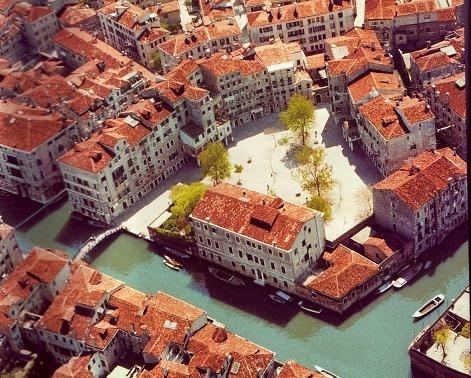 | ||
The Venetian Ghetto was the area of Venice in which Jews were compelled to live under the Venetian Republic. The English word "ghetto" is derived from the Jewish ghetto in Venice, originating from the Venetian ghèto and Italian ghetto. The Venetian Ghetto (incidentally, the first ghetto) was instituted on 29 March 1516, though political restrictions on Jewish rights and residences existed before that date. In 1797 the French army of Italy, commanded by the 28-year-old General Napoleon Bonaparte, conquered Venice, dissolved the Venetian republic, and ended the ghetto's separation from the city. In the 19th century, the ghetto was renamed the Contrada dell'unione.
Contents

Etymology

The origins of the name ghetto are disputed. The Oxford University Press etymologist Anatoly Liberman considers that all the proposed etymologies are wrong, and suggests a possible connection with German Gasse, Swedish Gata, Gothic Gatwo, meaning street. Among the theories that Liberman rejects are the following: getto (foundry), as ge- and ghe- have very different pronunciations in Italy, and the area would logically have been called "getti", foundries, in the plural; borghetto, diminutive of borgo, meaning little town, a nonspecific term; and the Hebrew word get, a divorce document, with no connection to "a place of forced separation".
Location and geography

The Ghetto is an area of the Cannaregio sestiere of Venice, divided into the Ghetto Nuovo ("New Ghetto"), and the adjacent Ghetto Vecchio ("Old Ghetto"). These names of the ghetto sections are misleading, as they refer to an older and newer site at the time of their use by the foundries: in terms of Jewish residence, the Ghetto Nuovo is actually older than the Ghetto Vecchio.
Culture

Though it was home to a large number of Jews, the population living in the Venetian Ghetto never assimilated to form a distinct, "Venetian Jewish" ethnicity. Four of the five synagogues were clearly divided according to ethnic identity: separate synagogues existed for the German (the Scuola Grande Tedesca), Italian (the Scuola Italiana), Spanish and Portuguese (the Scuola Spagnola), and Levantine Sephardi communities (The Scola Levantina). The fifth, the Scuola Canton, was built as a private synagogue for the four families, one of them the Fano family, who funded its construction, and also served the Venetian Ashkenazi community. Today, there are also other populations of Ashkenazic Jews in Venice, mainly Lubavitchers who operate a kosher food store, a yeshiva, and a Chabad synagogue.
Languages historically spoken in the confines of the Ghetto include Venetian, Italian, Judeo-Spanish, French, and German. In addition, Hebrew was traditionally (and still is) used on signage, inscriptions, and for official purposes such as wedding contracts (as well as, of course, in religious services). Today, English is widely used in the shops and the Museum because of the large number of English-speaking tourists.
Ghetto today

Today, the Ghetto is still a center of Jewish life in the city. The Jewish Community of Venice, that counts 500 people, is still culturally very active.
Every year, there is an international conference on Hebrew Studies, with particular reference to the history and culture of the Veneto. Other conferences, exhibitions and seminars are held throughout the course of the year.
The temples not only serve as places of worship but also provide lessons on the sacred texts and the Talmud for both children and adults, along with courses in Modern Hebrew, while other social facilities include a kindergarten, an old people's home, the kosher guest house Giardino dei Melograni, the kosher restaurant Hostaria del Ghetto, and a bakery. Along with its architectural and artistic monuments, the community also boasts a Museum of Jewish Art, the Renato Maestro Library and Archive and the new Info Point inside the Midrash Leon da Modena.
In the Ghetto area there is also a yeshiva, several Judaica shops, and a Chabad synagogue run by Chabad of Venice. Although only few of the roughly 500 Venetian Jews still live in the Ghetto, many return there during the day for religious services in the two synagogues which are still used (the other three are only used for guided tours, offered by the Jewish Community Museum).
Notable residents
Notable residents of the Ghetto include Leon of Modena, whose family originated in France, as well as his disciple Sara Copia Sullam. She was an accomplished writer, debater (through letters), and even hosted her own salon. Meir Magino, the famous glassmaker also came from the ghetto.
